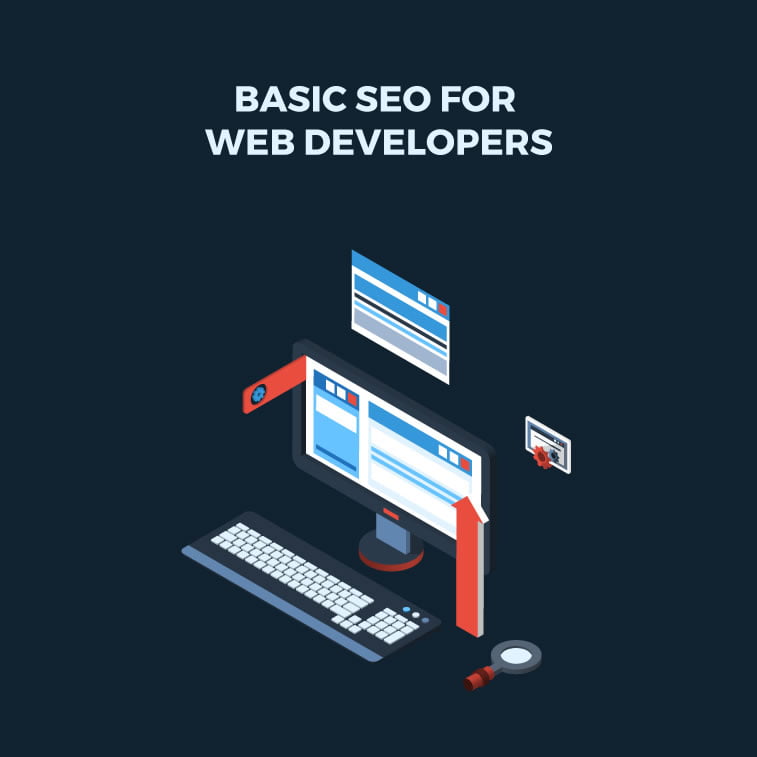Many clients come to us and assume that web development process equals an SEO-friendly website. After the initial surprise (when they learn that it does not), they start asking how is it possible that developers do not do that part of the job? What are we paying you for then?
Well, if you have come up with such questions, first – change the client. The person is obviously going to pester you for the job you are not familiar with. Or, there is the other option of asking this question: would you let your hairdresser do your garden? Even though the tasks seem similar, or even intertwined – which they certainly are, without any doubts – the job of an SEO specialist and a frontend developer differ quite greatly. Sure, they both code your website or make slight adjustments in the code, but what an SEO knows is in no way similar to a developer, et vice versa.
Of course, we completely agree that there must be a clear difference between the two positions, but we wanted to give you a glimpse of what an SEO actually does. If you do not want to remain silent the next time your client asks how to rank high on Google, here are some SEO basics for web developers you should know.
SEO Fundamentals for Developers
It is important to highlight at the very beginning that in order for a website to be ranked well, a set of rules needs to be respected. These SEO fundamentals will not create an SEO expert out of a web developer but are intended only to familiarize beginners with some fundamental specifications of an SEO-friendly website.
1. Structure
If you work for a web design agency, you would probably get the design files from a web designer with a clearly defined structure. There is no need to work on it in this case. However, if you are a freelance developer, a web designer is often skipped so it will probably be your responsibility to determine everything on it. First of all, keep in mind that websites are made for users, not robots. This means that when creating a website for your client, you need to create a logical structure which includes the main menu and its categories and subcategories.
Your homepage will probably have the highest authority of all pages on the website and it must contain small portions or summaries of all the most important elements. Featured products or services, reviews and testimonials, and blog fragments are only some of the elements your website should contain.
When it comes to single pages, you must also make sure that every page structure follows a certain logic. Put the most important page elements upfront, followed by the hierarchically less important information. Also, make sure that H-tags (headings) goes from the most important (H1) to least important (h2, h3, h4). Keep in mind that every page cannot have more than one H1 tags and try to make it the main page headline. H2 are usually subheadings, whereas products can have H3 tags.
And finally, you should include important information in the footer. This includes company title, address, preferably a Google map of the location, contact details, as well as social media links, terms of use and privacy policy links.
Extra tip: Invite robots to your site. Even though you create the website for users, Google’s crawlers must also be able to access and index your website. It is advisable to block access to the domain before it goes live if your developmental works are still on. However, when the site is live, the disallow directive in the robots.txt file must be on (without the forward slash). If it is on, you will invite spiders and user agents to crawl your website and it will soon find its positions in the SERP. Another option is to add <meta name=”robots” content=”noindex,nofollow” into the <head> of every web page.
2. Valid code
This may come as a surprise, but your HTML can sometimes end up being invalid. And that is completely fine because everyone can make mistakes. However, when the site goes live and it still has errors in the code, this may affect ranking negatively. In fact, valid code is one of Google’s ranking factors so you had better do something about it. If you want to learn more about this topic, go to validation basics page on w3.org.
There are a lot of online code validators, but we highly recommend W3’s code validator. The tool proved very useful to all developers, starting from juniors over mediors and all the way to experienced seniors and full-stack developers, and our SEOs love it!
3. Clean URLs
The third item on our list is a recommendation to create pretty URLs. Developers often forget that when you have created a logical structure, you need to name the folders (categories) and subfolders (subcategories) in a general way, so that they represent what they should. In this sense, we do not recommend creating generic URLs (such as domain.com/=item03568), but rather to focus on terms and keywords which describe the point of the page (such as domain.com/category/subcategory/product).
On the other hand, if you are developing a multilingual website, it is essential to pay attention that the links are also translated into different languages. This means that if you have a webshop in Spanish and English, your website product URLs should go like this: for the English website: domain.com/shoes/women-shoes/cat-heel.html, and in Spanish: domain.com/zapatos/mujer/zapatos-altos.
4. Meta tags
When it comes to other on-page SEO elements, you have probably heard of meta tags. It is essentially not on you to create meta tags and descriptions – this part is intended for the content and marketing team to deal with – however, if you added them, this would significantly boost your client’s website.
First of all, a page should have a clearly stated title by which you are informing the users and Google what content of the page is going to be about.
Second of all, meta descriptions should contain a few sentences which should interest the reader to click on that very page. For years, meta descriptions had to be up to 156 characters long, but now you can write even longer descriptions of up to 320 characters.
And third, image alt – every image on the web page should contain alternative text which is there to describe the image and help it rank better in the SERP.
For example, this article’s title is Basic SEO for developers, and its meta description can be seen on Google:

5. Schema markup
Structured data is another important point we should highlight. Even though it is not expected of you to know all Schema.org markups, we highly recommend you to educate yourself about it because you will be able to help your client with all the useful microdata you implement on their website.
Extra tip: If you are still a beginner in this and you still do not feel confident enough to implement schemas properly, it would be better to withhold yourself from this. Not only can you damage the website code, but also cause a Google penalty. In such cases, it would be better to hire an SEO expert or consultant to help you out until you feel completely ready to dig into Schema.org markup rules.
6. Go mobile
The days of unresponsive websites are long behind us. And for the better. In the age of Google and the Accelerated Mobile Pages Project (a.k.a. AMP), every website should have on its mind mobile users coming from different devices – tablet, phablet, smartphone, smartwatch, or any other devices they come up in the future. So, if you want Google to rank your site high in the SERP, make sure that it is adjusted for mobile phones and that all page content is showed properly, offering universally good user experience (UX).
7. Page speed
Speed is a very important prerequisite for good ranking. Pages today must be extremely lightweight and fast enough to be opened properly even in Guatemala or Vietnam or Uganda, or some other country with a slow-speed Internet. This part is highly dependent on the development part, so you need to make sure that the pages you code are performing in accordance with Google’s recommendations. You can easily check your page speed in Google’s PageSpeed Insights. The results will show you mobile and desktop performance and some tips on how to fix the issues if any.
8. Analytics
And the last thing, but not the least, you can do to help your client optimize their website is analytics. Every website aiming to rank on Google should implement Google Analytics from the very first day it goes live. Just download the asynchronous tracking code and add it to your website code, as described in our Beginner’s guide to Google Analytics. Mind you that the platform is currently being redesigned so maybe the next time you log in it will be shown differently. With the help of this useful tool, your client will be able to track visits and generate more website traffic from AdWords.
Wrapping things up, these are only the basic things you should be familiar with. Nobody will expect from you to learn everything by heart. As long as you are interested in discovering a completely new field of work can you broaden your knowledge, become more competitive, and offer more on the market. This way, not only will you profit, but also your clients.





